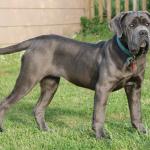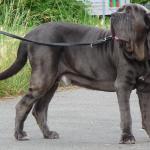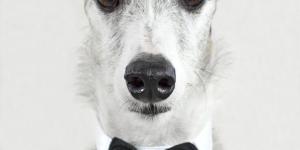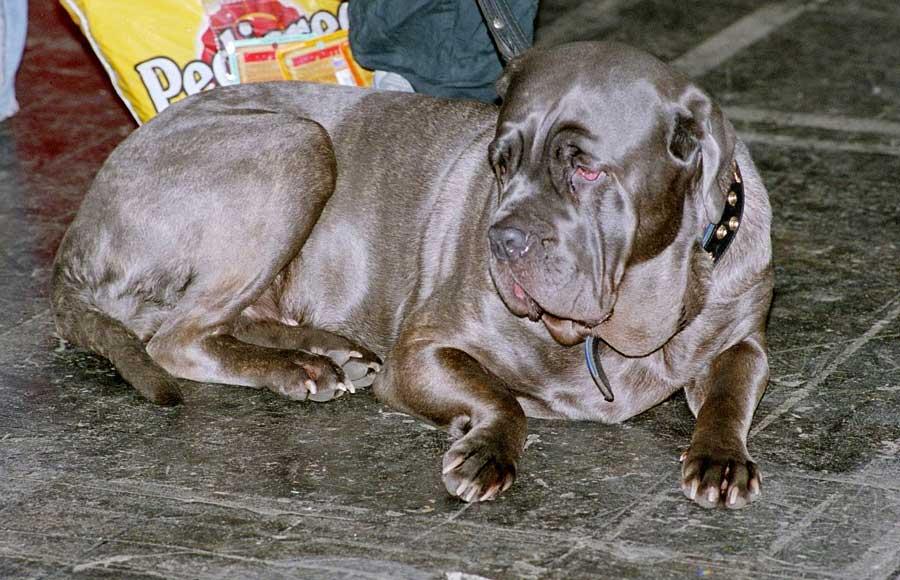Neapolitan Mastiff

The Neapolitan Mastiff is a large, robust and muscular dog with many folds in their skin. They are also known for their great loyalty, their powerful temperament and physical strength. This is why they were formerly used for war and as guard dogs. Nowadays, they are great pets. This is especially true for people who have a lot of space in their home and a lot of time to devote to these pets.
These dogs need to socialize and require positive training. For this reason, they are recommended for experienced dog companions. If you are thinking of adopting a pet and you're interested in the Neapolitan Mastiff, take a look at this breed sheet of the Neapolitan Mastiff and learn more about their history, physical characteristics and care, among other things.
- Europe
- Group II
- 5-14
- 14-18
- 18-22
- 22-27
- 27-31
- More than 31
- 2-7
- 7-22
- 22-55
- 55-100
- 100-220
- 8-10
- 10-12
- 12-14
- 15-20
- Low
- Meidum
- High
Origin
When the Romans invaded the British Isles, they carried their huge Molossus dogs with them that were used as war dogs. Molossus dogs, also known as Molossian hounds or Molossers, were dogs that belonged the Molossians, an ancient Greek tribe and kingdom. These dogs mercilessly attacked the enemies. However once in the British Isles, they encountered even fiercer dogs defending the islands. The Romans were so impressed with the ancestors of the English Mastiff that they crossed them with their Molossians. Thus, the predecessors of the modern Neapolitan Mastiff appeared. Those dogs were fierce, bloodthirsty and ideal for war.
With the passage of time, these Mastiffs were relegated almost exclusively to the region of Naples and were mainly used as guard dogs. In 1946, a dog show was held in Naples and a cytologist named Piere Scanziani recognized the Neapolitan Mastiff. These dogs had been hidden from the world until that moment. Then he devoted himself, along with other fans, to promoting the breed and increasing its population.
Today the Neapolitan Mastiff is a well-known dog throughout the world and has lost much of the aggressive and violent temperament of its ancestors.
Physical Appearance
This heavy, solid and stocky dog has a curious appearance due to its abundantly loose skin and dewlap. Their head is short and has numerous wrinkles and folds. Their skull is wide and flat. The naso-frontal depression (stop) is well marked. The color of the nose corresponds to their fur, being black in black dogs, brown in brown dogs and dark brown in dogs of another color. Their eyes are round, well separated from each other and slightly sunken. Their ears are triangular, small and high inserted. Formerly they were cut, but fortunately that practice has fallen into disuse and is even illegal in many countries.
The body of this Mastiff is longer than their height, thus presenting a rectangular profile. Their body is very robust and strong. Their chest is wide and open. Their tail is very thick at the base and gradually thins towards the end. The cruel custom of amputating it to about 2/3 of its natural length remains, but that custom is also falling into disuse and is increasingly rejected.
The Neapolitan Mastiff's coat is short, rough, hard and dense. It can be gray, leaden gray, black, brown, or reddish. Any of these colors can also be brindle. In addition, they may have small white spots on their forearm and fingertips.
Temperament and Character
The Neapolitan Mastiff enjoys being at home. They are quiet dogs, who enjoy a home life next to their family. They also like all kinds of outdoor activities since they need a good dose of daily physical activity. They are determined, independent, cautious and loyal. They tend to be reserved and distrustful of strangers but they can become a very sociable dog if encouraged as a puppy.
The Neapolitan Mastiff dog does not usually bark without reason. They are not too active for their size but it is important for them to have daily exercise. It is also crucial for them to have the company and affection any dog requires. As with all breeds, it is a sociable dog that needs to have a family nucleus to be happy. He will be excessively loyal and faithful to whoever cares for him and loves him.We must remember that, despite being a sociable dog and loyal to their family, the Neapolitan Mastiff may not be fully aware of their large size. Therefore, games with children and strangers should always be supervised. Both for the the safety of the dog and those who do not know their great physical strength.
This dog should be adopted by an experienced dog companion that is fully aware of the dog's behavior. So as to educate and train them in a positive matter. It is not a breed recommended for those who do not know anything about the care of dogs.
Health and Care
Neapolitan Mastiff hair care does not require much effort. An occasional brushing is enough to remove dead hair. It is also necessary to clean the skin folds frequently (especially those that are close to the mouth and can retain food debris) to prevent fungal growth and other dermal problems. These dogs drool a lot so they are not ideal for people obsessed with cleanliness.
Although they are not the most active dogs, Neapolitan Mastiffs need long walks every day and do not adapt well to life in small apartments. They need a medium or large space to be comfortable. It is highly recommended that they have access to a large garden. They do not tolerate high temperatures well so they must have a good shelter with shade.
This breed is prone to suffer from the following diseases:
Hip dysplasia
Cardiomyopathies
Demodicosis
Heatstroke
Elbow dysplasia
In addition, the reproduction of these dogs usually need assistance due to their great weight. It is common for fertilization to be carried out by artificial insemination and that births need caesarean section. To prevent and quickly detect any health problem, it will be optimal to visit the veterinarian every 6 months and strictly follow the vaccination schedule.
Education and Training
It is very important to socialize the Neapolitan Mastiff from an early age with all kinds of people, animals and environments to avoid future fears or reactive reactions. It is essential to understand that socialization is the key to enjoying a stable and healthy adult dog. On the other hand we must also bear in mind that it is very important to avoid situations that the dog can associate as bad. For example, a bad experience with a dog or a car could make their character change and become reactive.
Always use positive reinforcement and avoid punishments, hanging necklaces and physical damage. A dog with these characteristics should never be violently forced. For any suspicion of the appearance of behavioral problems you should go to a canine educator or ethologist and let yourself be guided by the experience of a professional.
It is fundamental to teach them the basic orders of obedience as it will encourage a good relationship with their dog companion, with their environment and with other people. It is highly recommended to spend between 5 to 10 minutes a day to review orders already learned and learn new ones. Encouraging intelligence games, new experiences and stimulating the physical and mental development of the dog will help them have a good temperament and help them make you happy.
Vídeo de Neapolitan Mastiff
Neapolitan Mastiff photos























